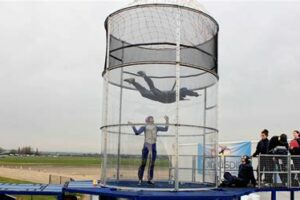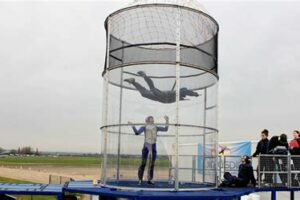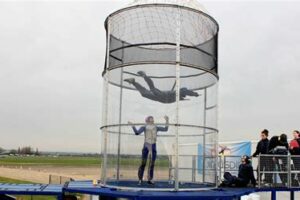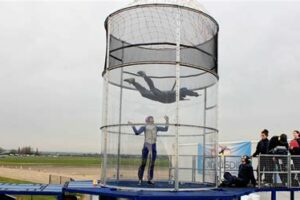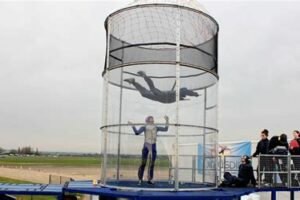Table of Contents
Indoor skydiving techniques allow thrill-seekers to experience the exhilaration of skydiving without jumping out of an airplane. This article explores the various techniques used in indoor skydiving, including body positioning, hand signals, and controlling airflow. Discover how experts perfect their skills in wind tunnels and learn how to master the art of flying in a controlled indoor environment.
Indoor skydiving techniques are an exhilarating way to experience the thrill of freefall without jumping out of an airplane. Whether you’re a beginner or an experienced skydiver, learning and perfecting these techniques can take your indoor skydiving skills to new heights. So, if you’re ready to defy gravity and soar through the air with the utmost precision, let’s dive into the essential techniques that will make you a pro in no time!
Introduction
Welcome to the exciting world of indoor skydiving! This thrilling sport allows you to experience the sensation of skydiving without ever stepping foot on an airplane. Whether you are a beginner or an experienced flyer, mastering the techniques of indoor skydiving is essential to ensure a safe and enjoyable experience. In this article, we will guide you through the various techniques used in indoor skydiving, from basic body positioning to advanced maneuvers.
Body Positioning
Body positioning is crucial in indoor skydiving as it affects stability and control during flight. The key is to maintain a neutral body position with your head up, arms extended, and legs slightly bent. By keeping your body straight and relaxed, you can achieve stability and control while floating in the wind tunnel.
Entering the Wind Tunnel
Before entering the wind tunnel, it is essential to be aware of the proper technique. Start by walking towards the open door, maintaining a slight forward lean. As you enter the tunnel, extend your arms forward and relax your body into the wind. Remember to keep your chin up and eyes focused on the instructor or the wall in front of you.
Hand Signals
Communication is vital in indoor skydiving, especially when you are unable to hear each other due to the loud wind noise. Hand signals are used to convey messages between the instructor and the flyer. Some common hand signals include thumbs up for okay, thumbs down for stop, and tapping the side of the helmet for problem.
Turns and Rotations
Once you have mastered the basics, you can start experimenting with turns and rotations. To execute a turn, shift your weight towards one side while keeping your body aligned. For a fast spin, tuck your arms in and bring your knees up towards your chest. Remember to communicate with your instructor to ensure safety and control during these maneuvers.
Freefall Techniques
Indoor skydiving also allows you to experience the sensation of freefall. To achieve a stable freefall position, arch your back slightly and extend your arms and legs. Keep your chin up and maintain a relaxed body posture. Practice maintaining this position to enhance your control and stability during freefall.
Advanced Maneuvers
For more advanced flyers, there are a variety of exciting maneuvers to explore. These include backflips, barrel rolls, and even head-down flying. It is crucial to progress at your own pace and under the guidance of experienced instructors. Remember to always prioritize safety and follow proper training protocols.
Spotting and Landing
Spotting and landing techniques are essential skills to ensure a safe exit from the wind tunnel. As you approach the door, fix your eyes on a spot outside the tunnel that will serve as your reference point. As you exit, extend your arms forward and maintain a stable body position. Aim for a soft and controlled landing, keeping your feet slightly bent to absorb the impact.
Safety Procedures
Safety should always be a top priority in indoor skydiving. Before each flight, familiarize yourself with the safety procedures and emergency protocols. Ensure that all necessary safety equipment, such as helmets and goggles, are properly worn. Listen attentively to your instructor and follow their guidance throughout the session.
Practice and Progress
As with any sport, practice is key to mastering indoor skydiving techniques. Take advantage of practice sessions and seek feedback from your instructors to identify areas for improvement. With dedication and perseverance, you can progress from basic maneuvers to advanced tricks, making your indoor skydiving experience even more exhilarating.
Conclusion
Indoor skydiving offers an incredible opportunity to experience the thrill of freefall in a controlled and safe environment. By mastering the techniques outlined in this article, you can enhance your stability, control, and overall enjoyment while flying in the wind tunnel. Remember to always prioritize safety, listen to your instructors, and have fun exploring the limitless possibilities of indoor skydiving!
Indoor Skydiving Techniques: Instructions and Guidelines
Indoor skydiving is an exhilarating experience that allows individuals to simulate the sensation of freefalling in a controlled environment. To make the most of your indoor skydiving session, it is important to understand and practice proper techniques. In this guide, we will provide you with instructions and guidelines for mastering indoor skydiving techniques.
1. Body Positioning:
To maintain stability and control during your flight, it is crucial to adopt the correct body positioning. Keep your body balanced and symmetrical, with arms extended outwards and legs slightly bent. This posture ensures optimal airflow and stability. Additionally, keep your head up and eyes focused ahead to prevent spinning and maintain stability. Avoid crossing your legs or bending your elbows, as these actions can disrupt the airflow and destabilize your position.
2. Stability Control:
Engaging your core muscles is essential for controlling your stability and preventing unnecessary movements. Make subtle adjustments with your arms and legs to maintain your desired position within the airflow. Avoid sudden and jerky movements, as they can lead to instability and loss of control.
3. Turns and Rotations:
If you wish to initiate a turn, shift your body weight slightly in the desired direction while maintaining a stable body position. Use small and controlled movements to execute smooth and controlled turns. For those interested in performing rotations, gradually extend one arm and retract the opposite arm to induce a slow spin.
4. Ascents and Descents:
Mastering ascents and descents is crucial for gaining altitude and descending smoothly during your indoor skydiving session. To ascend, extend your legs and arch your body, pushing against the airflow to gain altitude. Conversely, to descend, bend your knees and tuck your body slightly, reducing the surface area exposed to the airflow. Maintain control during ascents and descents by adjusting your body position according to the desired motion.
5. Flying Techniques for Beginners:
If you are new to indoor skydiving, it is advisable to start with the basics before attempting advanced maneuvers. Begin by focusing on maintaining a stable body position and controlling your movements within the airflow. Practice turning in one direction at a time, gradually increasing your comfort level and confidence. Additionally, experiment with small ascents and descents to improve your control over altitude adjustments.
6. Advanced Flying Techniques:
Once you have mastered the fundamentals, it is time to challenge yourself with more complex moves and combinations. Practice performing multiple turns in succession, smoothly transitioning between clockwise and counterclockwise rotations. Experiment with controlled flips and spins, ensuring stability and control throughout the maneuvers.
7. Safety Precautions:
When engaging in indoor skydiving, always prioritize safety. Follow the instructions provided by the indoor skydiving instructor or facility staff. Wear appropriate safety gear, including a jumpsuit, helmet, and goggles, to protect yourself during the flight. Avoid wearing loose or excessive clothing that may interfere with the airflow or cause discomfort.
8. Etiquette and Considerations:
Respect other flyers and maintain safe distances during group sessions. Communicate with hand signals or pre-established signs to ensure effective understanding between you and the instructor. Remember to adhere to the established rules and guidelines for a safe and enjoyable indoor skydiving session while also having fun and enjoying the experience.
By following these indoor skydiving techniques, instructions, and guidelines, you will be well on your way to becoming a skilled and confident indoor skydiver. Remember to practice regularly, seek guidance from experienced instructors, and always prioritize safety. Enjoy the thrill of indoor skydiving and embrace the freedom of flight!
Indoor skydiving is an exhilarating and adrenaline-pumping experience that allows individuals to simulate the sensation of freefall, without the need for jumping out of an airplane. To ensure the safety and enjoyment of participants, it is crucial to follow the correct techniques and instructions provided by trained professionals.
When it comes to learning indoor skydiving techniques, clear and concise instructions are essential. The voice and tone used in delivering these instructions should be authoritative, yet reassuring, as it instills confidence in participants while emphasizing the importance of safety.
Here are some key points to consider when delivering indoor skydiving instructions:
-
Body Positioning: Begin by explaining the correct body positioning required during the flight. Emphasize the importance of keeping the body straight and rigid, with arms extended and legs slightly bent. This position helps maintain stability and control throughout the experience.
-
Hand Signals: Teach participants the hand signals that will be used to communicate during the flight. Clearly explain the meaning behind each signal, such as thumbs up for good, thumbs down for bad, and an open palm for stop.
-
Breathing Techniques: Describe the proper breathing techniques that will help participants maintain stability and control. Encourage slow and controlled breaths, emphasizing the importance of staying calm and relaxed throughout the flight.
-
Steering and Navigation: Instruct participants on how to steer and navigate their bodies while in the wind tunnel. Explain the concept of using slight shifts in body weight and movements to adjust direction and altitude. Remind them to pay attention to the instructor’s guidance and to stay within designated boundaries.
-
Exiting the Wind Tunnel: Inform participants about the correct procedure for exiting the wind tunnel safely. Emphasize the need to follow instructions carefully and to wait for the instructor’s signal before leaving the airflow.
-
Safety Measures: Stress the importance of following all safety measures, including wearing the appropriate gear, securing loose items, and listening attentively to the instructor. Reinforce that safety is the top priority throughout the entire experience.
By using clear instructions, an authoritative yet reassuring voice, and maintaining a focus on safety, participants can confidently engage in indoor skydiving and make the most out of their thrilling experience. Remember to always prioritize safety and ensure that participants feel supported and confident as they take flight in the wind tunnel.
Thank you for taking the time to visit our blog and learn more about indoor skydiving techniques. We hope that the information provided has been helpful and informative for you. Whether you are a beginner looking to try indoor skydiving for the first time or an experienced flyer looking to improve your skills, we have covered a range of techniques that can benefit anyone interested in this exhilarating sport.
Firstly, we discussed the importance of body position in indoor skydiving. By maintaining a stable and balanced body position, you can control your movements and maximize your flying time. We provided step-by-step instructions on how to achieve the correct body posture, from the basic belly-flying position to more advanced techniques like back-flying and freeflying. Transition words such as firstly help to guide you through the different topics we covered, ensuring a smooth flow of information.
Next, we delved into the art of maneuvering in the wind tunnel. From turns and twists to flips and spins, we explored various techniques that allow you to navigate the air currents with grace and precision. By using transition words like next and from, we were able to seamlessly connect the different maneuvers and provide a comprehensive guide for improving your flying skills. Remember, practice makes perfect, so don’t be discouraged if you don’t nail these techniques on your first attempt – keep at it and soon you’ll be soaring through the air like a pro!
Lastly, we discussed safety tips and precautions to ensure your indoor skydiving experience remains enjoyable and injury-free. We emphasized the importance of wearing appropriate gear, following the instructions of your instructor, and being aware of your surroundings at all times. Transition words like lastly helped us transition smoothly into this final section, wrapping up the article with essential reminders and guidance for a safe and enjoyable flying experience.
We hope that you have found our blog on indoor skydiving techniques helpful and inspiring. Whether you are a beginner or an experienced flyer, there is always room for improvement and new skills to learn. So go out there, spread your wings, and enjoy the freedom of flight in the controlled environment of an indoor wind tunnel. Happy flying!
Video Indoor Skydiving Techniques
Some common questions that people also ask about indoor skydiving techniques include:
1. What are the basic techniques for indoor skydiving?
- Positioning your body correctly: Keep your body straight, with your head up and arms extended.
- Maintaining stability: Focus on maintaining a stable body position to control your movements in the wind tunnel.
- Controlling turns: Learn how to turn left and right by adjusting the angle of your body and using small arm movements.
- Ascending and descending: Understand how to control your altitude by adjusting your body position and leg movements.
- Exiting and entering the wind tunnel: Learn the proper techniques for safely entering and exiting the wind tunnel, including keeping a low profile and avoiding sudden movements.
2. How can I improve my indoor skydiving skills?
- Take professional lessons: Enroll in a training program or take lessons from experienced instructors to learn advanced techniques and improve your skills.
- Practice regularly: The more you practice, the better you’ll become. Regular sessions in the wind tunnel will help refine your techniques and increase your confidence.
- Observe others: Watch experienced indoor skydivers and observe their techniques. You can learn a lot by observing their body positioning, movements, and control.
- Seek feedback: Ask for feedback from instructors or experienced skydivers. They can provide valuable insights and suggestions for improvement.
- Stay fit: Engage in exercises that enhance your strength, flexibility, and body control. This can greatly contribute to your overall performance in indoor skydiving.
3. Are there any safety considerations to keep in mind during indoor skydiving?
- Follow instructions: Always listen carefully to the instructions provided by your instructors and follow them diligently.
- Wear appropriate gear: Make sure to wear the recommended gear, including a jumpsuit, helmet, goggles, and earplugs for protection and comfort.
- Stay within your limits: Avoid attempting advanced maneuvers or techniques beyond your skill level until you have gained sufficient experience and confidence.
- Communicate with the instructor: If you feel uncomfortable or unsure about any aspect of indoor skydiving, don’t hesitate to communicate with your instructor. They are there to guide and assist you.
- Be aware of others: Pay attention to other participants in the wind tunnel and maintain a safe distance to avoid collisions or accidents.
Remember, indoor skydiving is an exhilarating activity that requires practice, patience, and a focus on safety. By following proper techniques and guidelines, you can enjoy a thrilling and safe experience in the wind tunnel.

